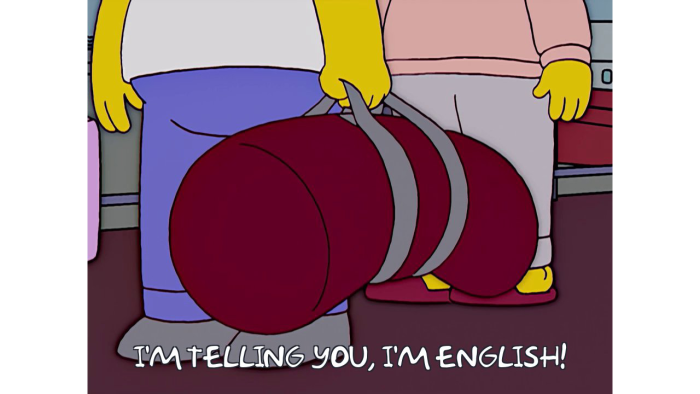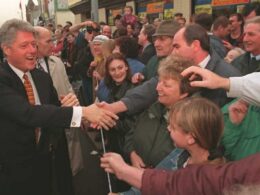Sam Lowe is a partner at Flint Global, where he advises clients on UK and EU trade policy. He is also a senior visiting fellow at King’s College London and runs Most Favoured Nation, a newsletter about trade.
The Tariff Man has tariffed, again.
This time, under the guise of reciprocity, he has moved beyond his passion for the number 25 and applied individualised “reciprocal” tariffs to countries, dependent on the extent to which they fall foul of a pretty arbitrary equation treat the US unfairly:
These individualised rates mean that where a product is from is increasingly important. Actually, I should rephrase that: where the US decides a product is from is increasingly important.
For example, under the terms of the new tariff action, if you export a product from Ireland to the US, it will be hit with an additional 20 per cent tariff. But if it is from the UK, the tariff will be 10 per cent.
When you take into account the cumulative impact of all the different tariff measures, the importance of origin becomes even more acute.
Let’s say you were making a hydraulic turbine (I’ve just picked a random bit of machinery from a list, don’t read too much into it) in the EU for export to the US, but it is primarily made of Chinese parts.
If the US decides the hydraulic turbine is of EU origin, the tariff would be 20 per cent plus the 3.8 per cent Most Favoured Nation tariff, making 23.8 per cent. Not ideal.
But if the US decides to treat the hydraulic turbine as Chinese, the tariff could be up to 82.8 per cent: 3.8 per cent MFN tariff + 20 per cent China-specific tariff + 34 per cent China reciprocal tariff + 25 per cent tariff because China buys oil from Venezuela. (Note: I’ve probably missed a product-specific tariff there, too and there might be extra duties relating to the steel content.) Existentially bad.

Indeed, this is what happened to Volvo back in 2019, when US customs decided their Swedish-made vehicles should be treated as Chinese and thus subject to a Trump 1.0-era 25 per cent tariff. (A useful, critical, summary of the decision by US customs lawyer Lawrence M. Friedman, here.)
But how exactly does the US determine the origin of an imported good?
Well, for exports not covered by a free trade agreement origin determinations are kinda … vibesy.
It’s not that there are no rules — the general focus is on whether a product is wholly obtained (eg a cow) in one jurisdiction or, if not wholly obtained, “the last country in which it has been substantially transformed into a new and different article of commerce with a name, character, and use distinct from that of the article or articles from which it was so transformed”.
It’s just that, in practice, it can be difficult to predict which way US customs will go on a specific issue.
For free trade agreements, there are usually product-specific rules that determine whether an exported good is local enough to benefit from the agreement’s preferential tariff treatment.
So far, under Trump 2.0, these preferential rules are most significant for trade between the US, Canada and Mexico.
For example, the recent action on car tariffs stipulates that if a car exported to the US from Canada or Mexico qualifies for the US, Canada, Mexico free trade agreement (USMCA), then the new 25 per cent tariff will only apply to the non-USA value of the vehicle. Dataviz:

(More on that, with further hand-drawn pictures, here.)
In practice, this could mean an effective additional tariff of well below the headline 25 per cent, depending on how much US “value” is embedded in the vehicle.
To qualify for USMCA the rules of origin are… complicated. USTR has a helpful summary:
The USMCA ROOs for motor vehicles require a specific amount of North American content in the final vehicle in order to qualify for duty-free treatment under the USMCA. The USMCA raised regional value content (RVC) requirements to 75 percent for passenger vehicles and light trucks, compared to 62.5 percent under the NAFTA. In addition, certain “core parts” must also meet the higher RVC thresholds for the entire vehicle to qualify. The USMCA also requires that at least 70 percent of a vehicle producer’s steel and aluminum purchases originate in North America. Finally, the USMCA introduced a new LVC rule that requires that a certain percentage of each producer’s qualifying vehicles be produced by employees making an average of $16 per hour. Collectively, these new requirements are intended to incentivize increased investment in autos and automotive parts production within the United States and North America.
So, on the one hand, significant country-by-country tariff differentials create new incentives for supply chain … *ahem* … optimisation. But on the other, US determinations of origin are not always the easiest to predict and will (in my opinion) probably become increasingly weighted towards ensuring products are classified as being from whichever country delivers the highest tariff.
For example, see this caveat to the USMCA wheeze described above:
(3) If U.S. Customs and Border Protection (CBP) determines that the declared value of non-U.S. content of an automobile, as described in clause (2) of this proclamation, is inaccurate due to an overstatement of U.S. content, the 25 percent tariff shall apply to the full value of the automobile, regardless of the actual U.S. content of the automobile. In addition, the 25 percent tariff shall be applied retroactively (from April 3, 2025, to the date of the inaccurate overstatement) and prospectively (from the date of the inaccurate overstatement to the date the importer corrects the overstatement, as verified by CBP) to the full value of all automobiles of the same model imported by the same importer. This clause does not apply to or otherwise affect any other applicable fees or penalties.
But I do wonder if all of this means that, in the aggregate, the true impact becomes a question of capacity and enforcement. Or rather, how difficult does the US really want to make life for importers?
Because, as per the general argument about the global economy made in FTAV contributor Dan Davies’s book, Lying for Money, the secret ingredient of an efficient global trading system is [a tolerance of some] crime. By this, I mean that checking every single product that enters a country would be incredibly resource-intensive and bring trade to a grinding halt.
In this context, if US border enforcement continues as it always has, you would expect most companies to accurately declare origin to the greatest extent possible and while some will accidentally get it wrong, and some will commit crimes, only a few will get pulled up on it every now and then.
However, in his press conference Trump threatened to jail people for 10 years if they try to claim the wrong tariff rate. And if the US decides to crack down — which it will need to if it wants to enforce the tariff differentials and achieve the ultimate objective of forcing companies to make stuff in the US — then, well, let vibes and chaos reign.
Further reading:
— Reciprocal tariffs: you won’t believe how they came up with the numbers
— The stupidest chart you’ll see today
— Wall Street analysts anguish over ‘Liberation Day’
Source link









